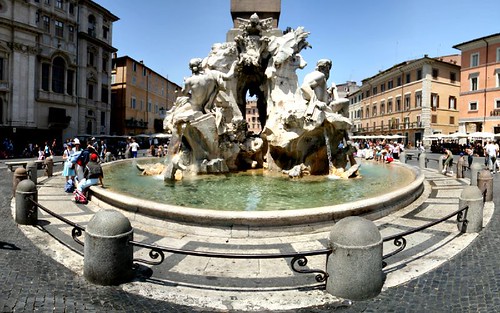
This view over the Piazza Navona is part of one of the panoramic images found on the PanoramicEarth.com Tour of Rome. There are over 100 images taken from around
Full 360° panorama of the Piazza Navona
There are a few things that dominate the Piazza Navona of today. The first is the huge Fontana dei Quattro Fiumi in the centre of the long oval square topped with a large obelisk. The other is the shear number of cafés and restaurants that line the piazza. In this sense, the piazza almost feels like the Tardis from Dr.Who as it seems that surely there must be more seating space than the construction of the square could possibly allow for.
Piazza Navona started off life as the Stadium of Domitian, built in 85 AD to hold some 30,000 spectators, and the square still retains the original shape. Most of the streets lead into Piazza Novana where there were gates to the original stadium. Athletes used to enter along Via Agonale, and the area was known as Campus Agonis in the middle ages. From this through ‘in Agonale’ and ‘n’Agona’ the name ‘Navona’ is derived.
Piazza Navona fell into disrepair after the fall of the
Fontana dei Quattro Fiumi or 'Fountain of the Four Rivers'
This is one of Bernini’s most famous works, along with the Piazza S Pietro in the
Danube for
Ganges for India
Nile for
Rio della Plata for
Each figure is semi-prostrate before the obelisk places at the centre of the tower. This is meant to symbolize the then sovereignty of the pope over the temporal domains. The obelisk itself was made in
The image here shows two of the statues at the base of the fountain, and the hollow in the massive travertine rocks. In the 17C to 19C the piazza was regularly flooded by stopping up the fountain outlets and the people would play in the water. The full panoramic image shown on the Rome tour by PanoramicEarth.com. For better appreciation of this image go to the collection on Flickr.
For more articles on
2 comments:
Hi,
Just wanted to correct you.
Ganges is the most sacred river in India and not Africa. Hope you will make the corrections.
Thanks
Jay Annadatha
Jay, thanks for that, bit of a stupid mistake, now corrected.
Post a Comment